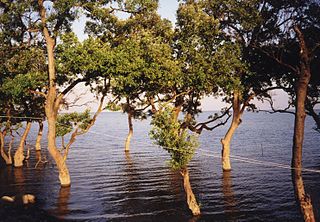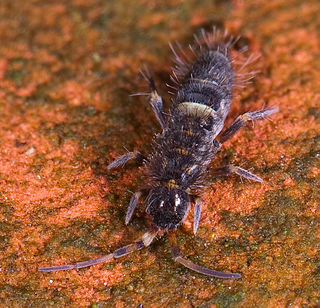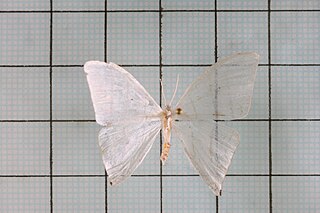
Bifidobacterium animalis is a gram-positive, anaerobic, rod-shaped bacterium of the Bifidobacterium genus which can be found in the large intestines of most mammals, including humans.

Don Hoi Lot is a sandbar off the coast of Samut Songkhram Province at the northwestern tip of the Bay of Bangkok. The sediments of the Mae Klong River together sediments from the sea form a system of mudflats, which are populated by razor clams, which also gave the site its Thai name. The site has the largest population of this species, which is endemic to the northern Gulf of Thailand. Also 18 bird and 42 invertebrate species are recorded at the mudflats and the adjoining coastal mangrove forests. The mudflat Don Nai is on the coast. Nearby, the highly revered shrine of Prince Chumphon Khet-Udomsak attracts Thai visitors.

Sclerophrys regularis, commonly known as the African common toad, square-marked toad, African toad, Egyptian toad, African bouncing toad and Reuss's toad, is a species of toad in the family Bufonidae. It is found widely in the Subsaharan Africa, with its range extending to the oases in Algeria and Libya as well as to northern Nilotic Egypt. Specifically, it is found in Angola, Benin, Burkina Faso, Cameroon, Cape Verde, Central African Republic, Chad, Republic of the Congo, Democratic Republic of the Congo, Ivory Coast, Egypt, Ethiopia, Gabon, Ghana, Guinea, Guinea-Bissau, Kenya, Liberia, Mali, Niger, Nigeria, Rwanda, Senegal, Sierra Leone, Sudan, and Uganda.

Springtails form the largest of the three lineages of modern hexapods that are no longer considered insects. Although the three orders are sometimes grouped together in a class called Entognatha because they have internal mouthparts, they do not appear to be any more closely related to one another than they are to all insects, which have external mouthparts.

Campiglossa is a genus of fruit flies in the family Tephritidae. There are at least 190 described species in Campiglossa.

Leptotes cassius, the Cassius blue or tropical striped blue, is a butterfly of the family Lycaenidae. It is found in North America in Florida including the Keys, Texas south through the Caribbean, Mexico, and Central America to South America. Strays have been found in New Mexico, Kansas, Missouri, South Carolina, North Carolina and Virginia.

Ditrigona is a genus of moths belonging to the subfamily Drepaninae. The genus was erected by Frederic Moore in 1888.

Acantholipes regularis is a species of moth in the family Erebidae first described by Jacob Hübner in 1813. It is found in southern Europe, the Near East and Middle East, western China, Afghanistan, Iran and Saudi Arabia.

Conus regularis, common name the regular cone, is a species of sea snail, a marine gastropod mollusk in the family Conidae, the cone snails and their allies.

Scaphinotus is a genus of beetles in the family Carabidae. There are at least 60 species, all native to North America. They eat snails and are generally limited to the moist environments where snails live. These beetles are flightless.

Halityle regularis, commonly known as the mosaic cushion star, is a species of sea star in the family Oreasteridae. It is the sole species in the genus Halityle.

Folsomia candida is a species of springtail in the family Isotomidae. It is found in soil in many locations around the world, having been spread inadvertently by humans. It reproduces by parthenogenesis and has been used as a model organism in research.

Eurema regularis, the even-bordered grass yellow or regular grass yellow, is a butterfly in the family Pieridae. It is found in Senegal, Guinea, Sierra Leone, Liberia, Ivory Coast, Ghana, Togo, Nigeria, the Republic of the Congo, Angola, the Democratic Republic of the Congo, Ethiopia, Rwanda, Burundi, Kenya to Zambia, eastern Zimbabwe and western Mozambique. The habitat consists of woodland and forest margins.

iNaturalist is an American 501(c)(3) nonprofit social network of naturalists, citizen scientists, and biologists built on the concept of mapping and sharing observations of biodiversity across the globe. iNaturalist may be accessed via its website or from its mobile applications. iNaturalist includes an automated species identification tool, and users further assist each other in identifying organisms from photographs and even sound recordings. As of 9 July 2024, iNaturalist users had contributed approximately 197,660,888 observations of plants, animals, fungi, and other organisms worldwide, and 290,007 users were active in the previous 30 days.

Myrmecia regularis is a species of ant endemic to Australia. A member of the genus Myrmecia in the subfamily Myrmeciinae, it was first described by American entomologist Walter Cecil Crawley in 1925. These ants are medium to large in size, measuring 10 to 20 millimetres, and they are bright brownish-red in colour. Queens and workers share similar morphological features, but they can be distinguished by the noticeable size difference. Males also look similar, but collected specimens are too damaged to be examined properly.

Micromussa regularis is a species of coral found in Indo-Pacific waters from Australia to the western Pacific Ocean. It is usually uncommon throughout its range, but can be more common locally. It has a narrow depth range, and so is susceptible to coral bleaching and disease. It is also threatened by the global decline in coral reef habitats.
Epierus regularis is a species of clown beetle in the family Histeridae. It is found in North America.
The regular miner bee is a species of miner bee in the family Andrenidae. It is found in North America.

Folsomia is a genus of elongate-bodied springtails in the family Isotomidae. There are more than 110 described species in Folsomia.
Pteronarcella regularis, the dwarf salmonfly, is a species of giant stonefly in the family Pteronarcyidae. It is found in North America.















